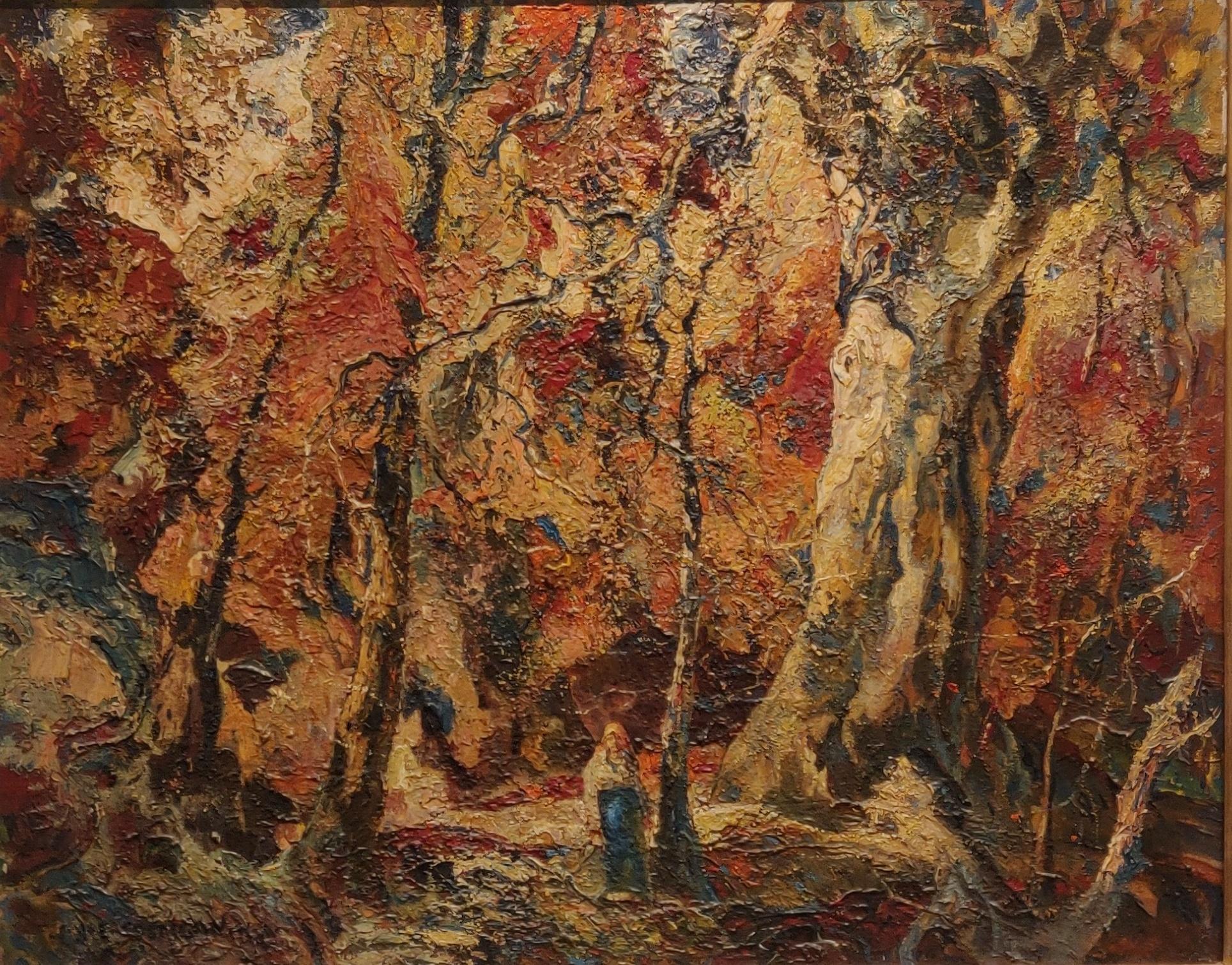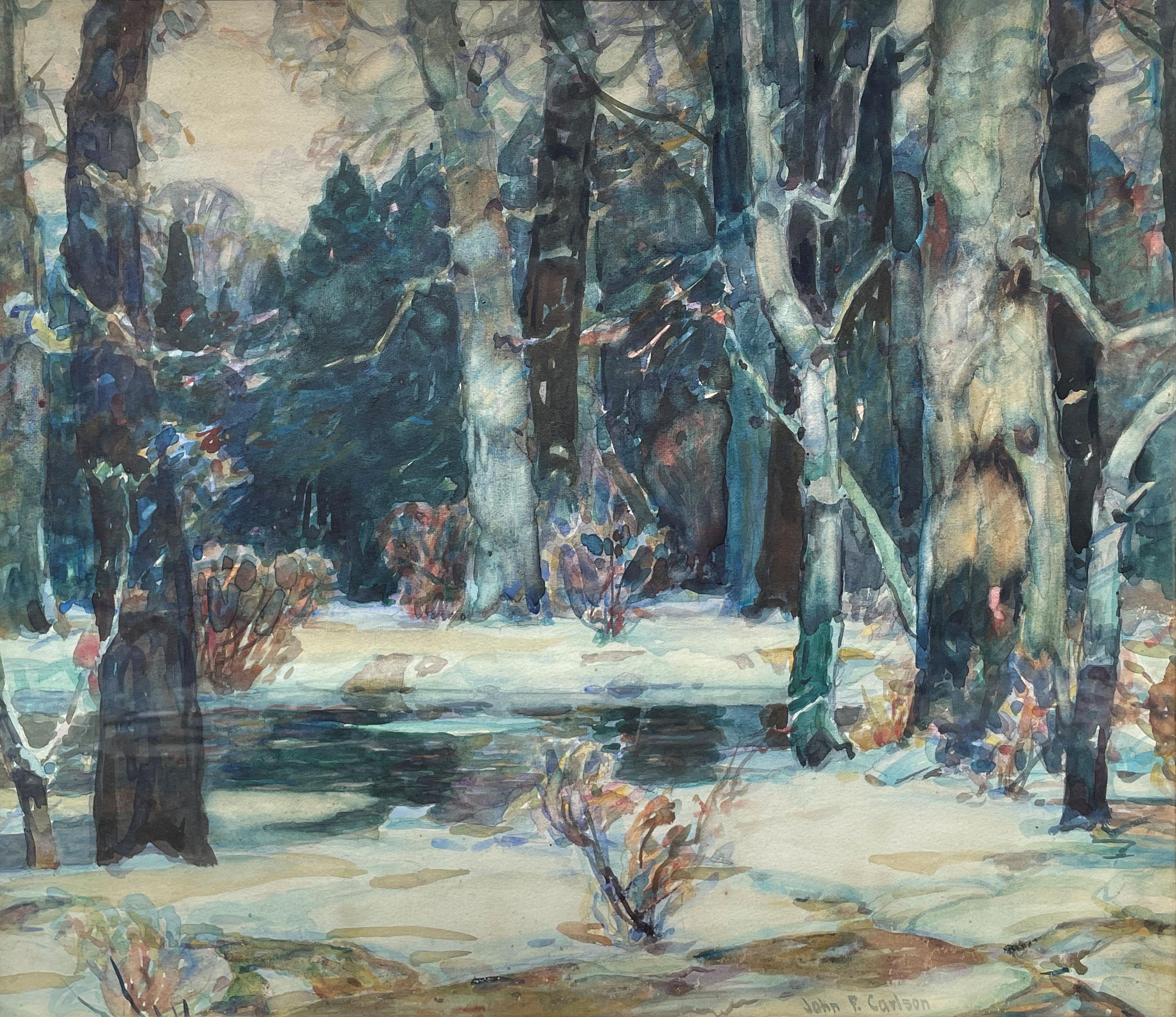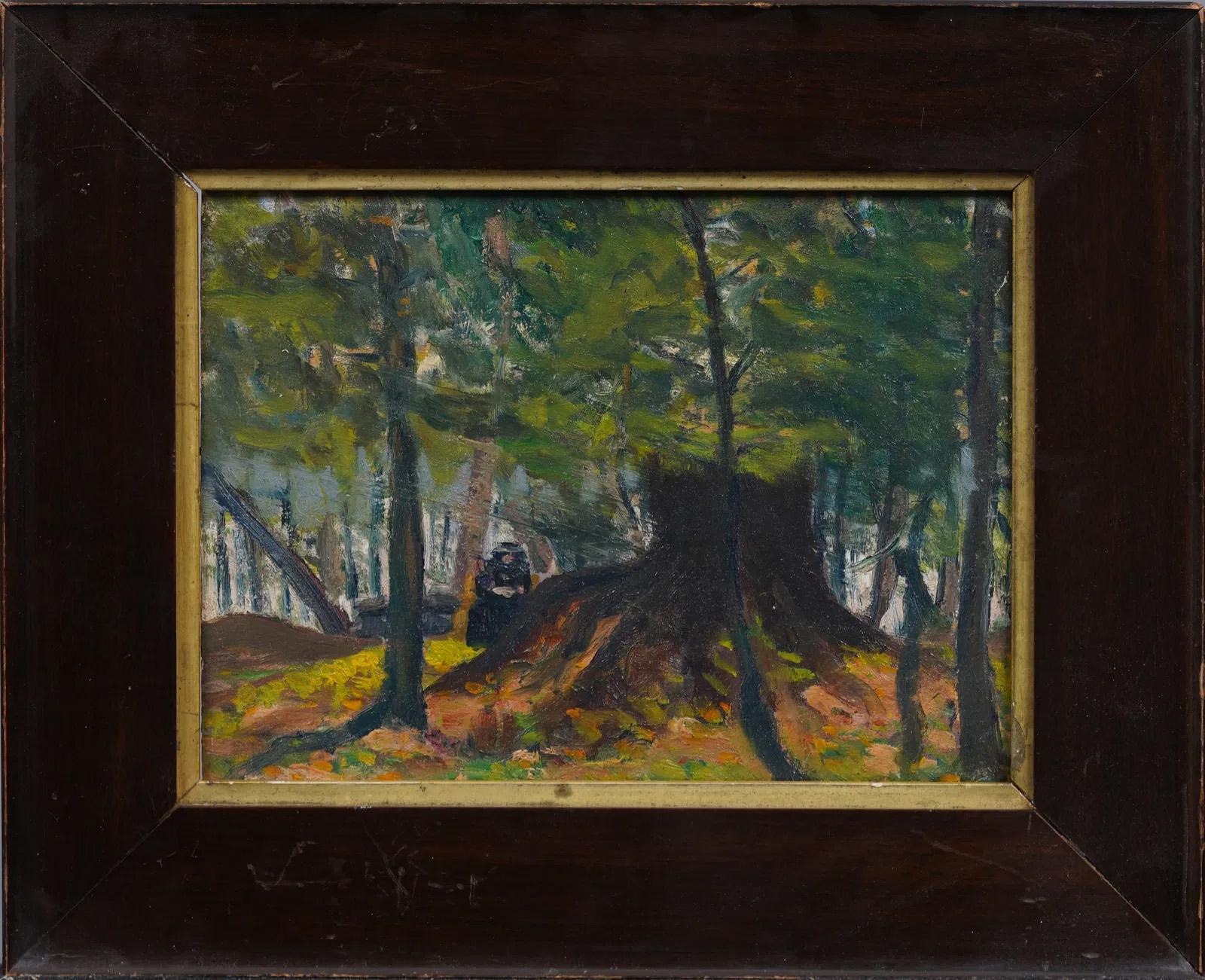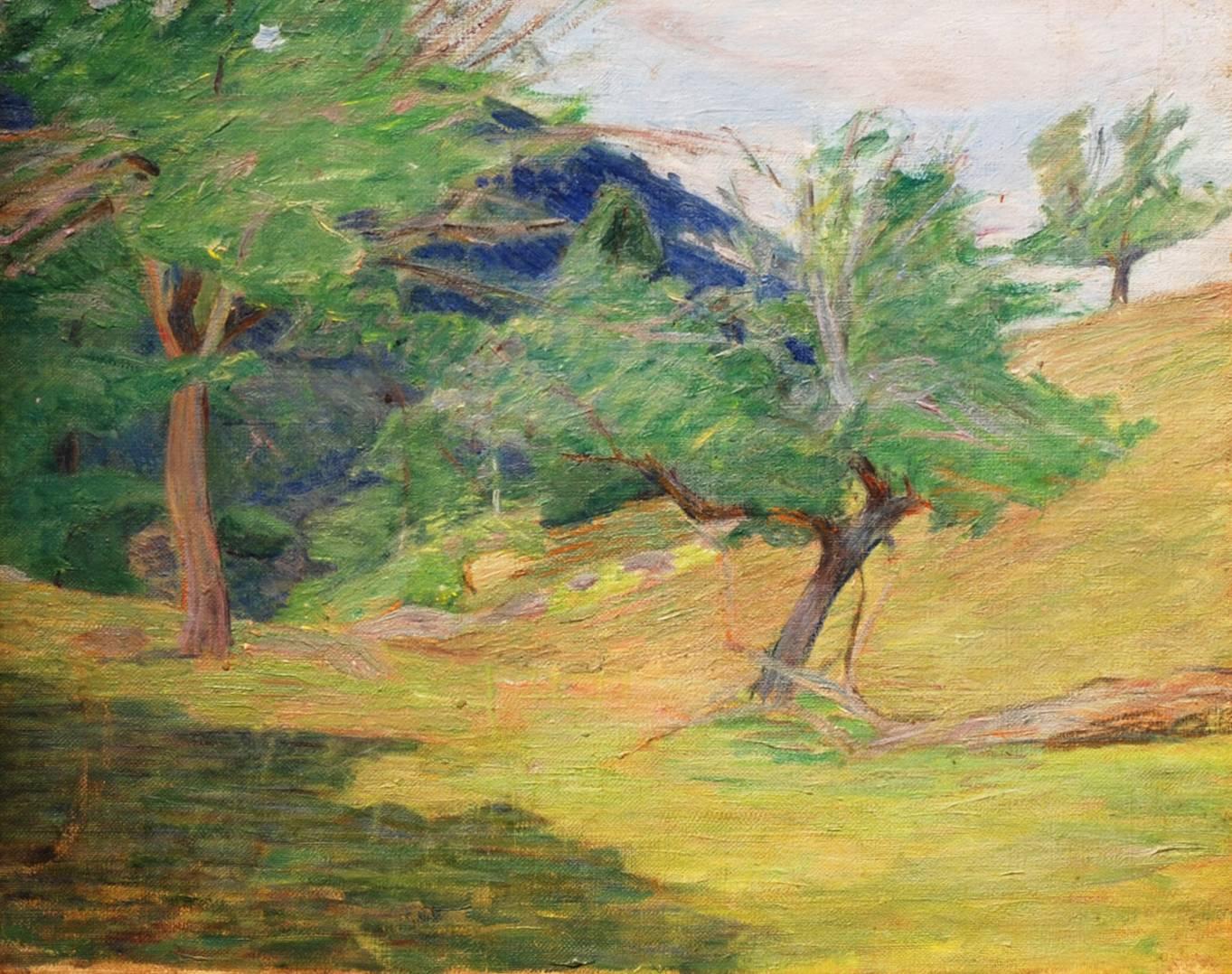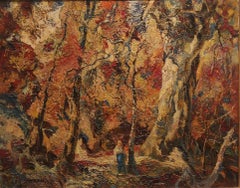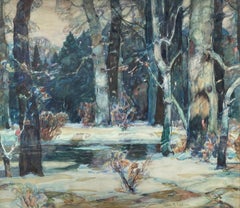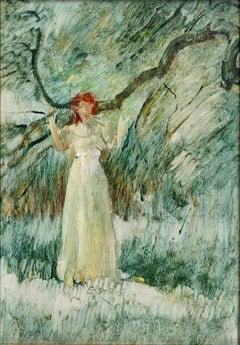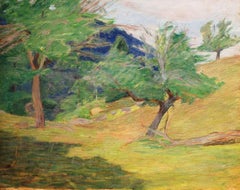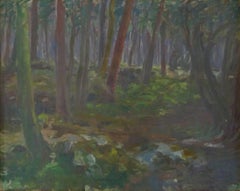Items Similar to "Through the Woods" John E. Costigan, Early 20th Century Landscape Painting
Want more images or videos?
Request additional images or videos from the seller
1 of 11
John E. Costigan"Through the Woods" John E. Costigan, Early 20th Century Landscape Painting
$19,000
£14,424.48
€16,498.52
CA$26,545.76
A$29,524.67
CHF 15,416.87
MX$359,283.88
NOK 196,896.92
SEK 184,654.58
DKK 123,134.80
Shipping
Retrieving quote...The 1stDibs Promise:
Authenticity Guarantee,
Money-Back Guarantee,
24-Hour Cancellation
About the Item
John Edward Costigan
Through the Woods
Signed lower right
Oil on masonite
30 x 27 1/2 inches
John Costigan was a self-taught painter and trained printer distinguished by his impressionistic style and affinity for bucolic scenes. Born on February 29, 1888, in Providence, Rhode Island he was orphaned in adolescence. Costigan was taken in by his aunt and uncle, vaudeville performers Helen and Jeremiah Cohan. He began working as an errand boy and afterward held jobs in local costume jewelry factories. In 1903, Costigan moved to New York City through the assistance of his aunt and uncle, who obtained a position for him with the H.C. Miner Lithographing Company. There he resided in a theatrical boarding house and attended rehearsals for the works of his playwright cousin, George M. Cohan. The Miner Company produced posters for such theatrical works. Though Costigan began as a pressroom helper, through his twenty-eight year employment with the company he learned about printing through apprenticeships, and began applying his artistic talent professionally. Once promoted to sketch artist, Costigan worked designing posters for the Ziegfeld Follies, as well as silent pictures like D.W. Griffith’s Birth of a Nation.
Costigan’s formal art instruction was limited to a few weeks at the Art Student’s League where he studied under William Merritt Chase and George Bridgman. He stayed committed instead to a studio on 14th Street called the Kit Kat Club, where illustrators and newspaper artists spent nights sketching from live models in an informal atmosphere. By the age of thirty, Costigan exhibited at the Corcoran Gallery of Washington D.C., in addition to the MacDowell Club, and Babcock Gallery in New York. The year following his showing at the Babcock Gallery Costigan joined the army as a private and served in World War I. During his 1918-1919 service he experienced action while positioned in France with the 52nd “Pioneer” Infantry Division.
Costigan married sculptor and professional artist’s model Ida Blessin in 1919, and the couple retreated to Orangeburg, New York. A twenty-five mile distance from New York City, Orangeburg was situated by the Hudson River. The same area had served as a destination for Costigan’s weekend sketch trips in previous years. Through the twenties, Costigan gained greater recognition with a number of exhibitions, including showings at the Art Institute of Chicago, Salmagundi Gallery and Corcoran Gallery. An influx of awards for his work in oil and watercolor helped secure his notoriety, beginning in 1920 with an award from the National Academy of Design. In 1928, Costigan was made an Academician to the National Academy of Design, leading him to add the distinction of “N.A.” (National Academy) to his signature.
As Costigan continued to exhibit and receive awards in painting and printing, he also remained reliant on outside work. After the close of the Miner Company, Costigan taught at the Art Students League and in his Orangeburg home, found employment in a defense plant as a machine operator during World War II, and took up commercial work illustrating McCall’s Bluebook magazine for five years. Nevertheless, during the 1940s he exhibited at both the Whitney Museum of American Art and the Carnegie Institute. Costigan’s place in the fine art world was reaffirmed in 1968 with the launch of a retrospective exhibition from the Smithsonian Institute. This exhibit was comprised of works in Costigan’s varied mediums, provided by a range of public and private collections across the country. After premiering at the Paine Art Center and Arboretum in Oshkosh, Wisconsin, the Smithsonian Institute facilitated the national circulation of the works.
Costigan’s body of work across the mediums of oil, watercolor, etching, and lithography provide an extensive exploration of the pastoral, yet also document the realities of the artist’s rural life. Family members served as models for his scenes, with wife Ida a primary model for the solitary women and motherly figures. His five children, too, and later grandchildren, were influential in providing a basis for many compositions. Despite these ties to specifications of time and biographical experience, Costigan’s scenes are also outside of time, in the peaceful and somewhat utopian world of the pastoral. Cositgan gave an inspired, energetic approach to the simple joys of the bucolic, offering reflection and solace in his subjects. The strong sense of movement developed through a varied palette and the handling of light, line, and composition fills the works with vitality. The rustic figures hold an equal weight with their surroundings, with the two bound together by the artist’s bold rendering of light and color. From muted forest scenes to opulent beachside settings, Costigan developed luminescent and highly sensitive scenes of domesticity and repose. The atmospheric qualities of the works develop a sense of gravity across scenes of bathers, mothers with children, and single introspective figures, as well as his non-figural landscape and still-life subjects.
Costigan continued to paint into his eighties, even as his eyesight began to fail. He died from pneumonia at the age of eighty-four on August 5, 1972, in Nyack, New York. Prior to his death he was honored through the Artist’s Fellowship with the Benjamin West Clinedinst Medal in acknowledgement of the achievements of his half-century long career. Costigan’s self-cultivated personal vision produced an impressive body of work, offering imaginative executions of the simple moments from domestic and rural life.
- Creator:John E. Costigan (1888 - 1972, American)
- Dimensions:Height: 36.25 in (92.08 cm)Width: 36.25 in (92.08 cm)
- More Editions & Sizes:Unique workPrice: $19,000
- Medium:
- Period:
- Condition:
- Gallery Location:New York, NY
- Reference Number:1stDibs: LU1841214417162
About the Seller
5.0
Platinum Seller
Premium sellers with a 4.7+ rating and 24-hour response times
Established in 2022
1stDibs seller since 2022
114 sales on 1stDibs
Typical response time: <1 hour
- ShippingRetrieving quote...Shipping from: New York, NY
- Return Policy
Authenticity Guarantee
In the unlikely event there’s an issue with an item’s authenticity, contact us within 1 year for a full refund. DetailsMoney-Back Guarantee
If your item is not as described, is damaged in transit, or does not arrive, contact us within 7 days for a full refund. Details24-Hour Cancellation
You have a 24-hour grace period in which to reconsider your purchase, with no questions asked.Vetted Professional Sellers
Our world-class sellers must adhere to strict standards for service and quality, maintaining the integrity of our listings.Price-Match Guarantee
If you find that a seller listed the same item for a lower price elsewhere, we’ll match it.Trusted Global Delivery
Our best-in-class carrier network provides specialized shipping options worldwide, including custom delivery.More From This Seller
View All"Autumn Wood Interior" John E. Costigan, Early 20th Century Landscape Painting
Located in New York, NY
John Edward Costigan
Autumn Wood Interior, 1946
Signed, lower left "J.E. Costigan N.A."
Oil on canvas
24 x 30 inches
John Costigan was a self-taught painter and trained printer dis...
Category
1940s Impressionist Landscape Paintings
Materials
Oil
John E. Costigan"Autumn Wood Interior" John E. Costigan, Early 20th Century Landscape Painting, 1946
$19,200 Sale Price
20% Off
"Forest Landscape" John F. Carlson, circa 1925 American Impressionist Landscape
By John F. Carlson
Located in New York, NY
John F. Carlson
Forest Landscape, circa 1925
Signed lower right
Watercolor on paper
Sight 21 x 24 1/2 inches
The native Sweden John Fabian Carlson became a household name in New Yo...
Category
1920s American Impressionist Landscape Paintings
Materials
Paper, Watercolor
"Into the Woods" Henry Prellwitz, Lyrical Woman In Wooded Landscape Painting
By Henry Prellwitz
Located in New York, NY
Henry Prellwitz
Into the Woods
Oil on board
11 1/2 x 8 3/4 inches
Henry Prellwitz studied art at the Art Students League of New York, where his chief mentor was Thomas Wilmer Dewing; he later became its director.[3] He also studied at the Académie Julian in Paris.
In 1892, he set up his studio in the Holbein Studios building on West 55th Street in Manhattan, where his future wife, the artist Edith Mitchill, also had a studio. They married in 1894 and had a son, Edwin.
By the mid 1890s, he was teaching portrait painting at the Pratt Institute, where one of his students was the Cubist artist Max Weber.
In 1899, Henry and Edith moved to the north shore of Peconic Bay on Long Island, where their artist friends Irving Ramsay Wiles and Edward August Bell were already established. They painted plein air paintings and also worked in adjoining studios at High House, their Peconic Bay home.
Prellwitz painted Impressionist and Tonalist waterscapes of Peconic Bay and allegorical figure paintings such as the 1904 Lotus and Laurel. He exhibited mainly on the east coast and at expositions like the St. Louis World's Fair, where he won a silver medal. He won the Third Hallgarten Prize from the National Academy of Design (NAD) in 1893 for The Prodigal Son, and his Venus won the Thomas B. Clarke Prize at the 1907 NAD exhibition for the best figure composition by an American citizen painted in the United States.
Both Prellwitzes disappeared into obscurity for several decades after their deaths in the early 1940s. Rediscovered in the 1980s, they have been called one of the best-kept secrets in art...
Category
Early 20th Century Modern Figurative Paintings
Materials
Oil, Board
$3,600 Sale Price
20% Off
"Eleventh Century Romance, " Walter Griffin, American Impressionism Landscape
By Walter Griffin
Located in New York, NY
Walter Griffin (1861 - 1935)
Eleventh Century Romance
Oil on canvas
34 x 36 inches
Signed lower right; signed on the reverse and titled on the stretche...
Category
Early 20th Century American Impressionist Landscape Paintings
Materials
Canvas, Oil
"Frawg Hollow, Virginia" Corwin Knapp Linson, Southern Country Landscape
By Corwin Knapp Linson
Located in New York, NY
Corwin Knapp Linson
Frawg Hollow, West Virginia
Signed and titled lower left
Oil on canvas
24 x 28 inches
Provenance
The artist
Artist's family by descent
Corwin Knapp Linson was ...
Category
Early 1900s Academic Landscape Paintings
Materials
Oil, Canvas
"Stick Season" Sylvia Wald, 1948 Abstracted Wooded Landscape Painting
Located in New York, NY
Sylvia Wald
Stick Season, 1948
Signed and dated lower right
Oil on canvas
40 x 25 inches
Born in Philadelphia, Sylvia Wald studied at the Philadelphia Sc...
Category
1940s Abstract Expressionist Abstract Paintings
Materials
Canvas, Oil
You May Also Like
Antique American Impressionist Woodland Interior 19th Century Landscape Painting
Located in Buffalo, NY
Nicely painted 19th century woodland interior landscape painting. Oil on board. Framed. Image size, 7.5 by 9.5 inches. Housed in period frame.
Category
1890s Impressionist Abstract Paintings
Materials
Canvas, Oil
$380 Sale Price
20% Off
A Wooded Landscape, 20th Century Oil Landscape
Located in London, GB
Percy Thornton
20th Century
Landscape
Oil on board
Image size: 15½ x 19 inches
Framed
Category
20th Century Landscape Paintings
Materials
Oil, Board
"Grove of Trees, " Lucy Hariot Booth, oil, landscape, impressionist, late 19th c.
By Lucy Hariot Booth
Located in Wiscasset, ME
American Impressionist landscape painter Lucy Hariot Booth was born in 1869 in Iowa and studied at the Art Students League in New York under Carroll Beckwith, Willard Metcalf, J. Alden Weir and John Henry Twachtman. Booth also painted at Weir Farm in Branchville with Albert Pinkham Ryder...
Category
Late 19th Century Impressionist Landscape Paintings
Materials
Canvas, Oil
The Forest - Oil Painting Russian Art
By Constantin Kousnetsoff
Located in London, GB
This is an original oil painting on canvas by the Russian artist Constantin Kousnetsoff.
Condition: Good condition. Unexamined out of the frame.
Category
20th Century Landscape Paintings
Materials
Canvas, Oil
Cedric Gray - Framed Early 20th Century Oil, The Forest Falls
By Cedric Gray
Located in Corsham, GB
This atmospheric landscape painting captures the raw beauty of a cascading waterfall surrounded by a dense forest of fir trees. The artist skilfully depicts the interplay of light an...
Category
20th Century Landscape Paintings
Materials
Oil
Charles Binard - Mid 20th Century Oil, Woodland Landscape
Located in Corsham, GB
Well presented in a dark wood frame with gilt slip. Signed. On board.
Category
20th Century Landscape Paintings
Materials
Oil
More Ways To Browse
E M Washington
American Pastoral Landscape
1928 Jewelry Vintage
Landscapes Oil Artist H Hudson
C Babcock
William Griffiths
Vintage Premier Designs Jewelry
Wisconsin Poster
Ziegfeld Follies
Vintage Ziegfeld Follies
Bound Newspaper
Providence Vintage Jewelry
W C Griffiths
Joy Division Poster
Vintage Forest Service Posters
John Morning
Prairie Landscape Art
Mexican Church
